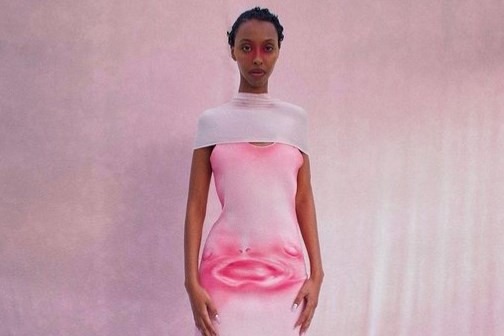
Anika Leila turns manky, out-of-date make-up into monstrous wearable art
Daubing her creations with foundation, blusher, and eyeshadow to create sinister, creepy-cute faces, the recent CSM grad’s designs are like nothing you’ve seen before
Take exquisite draping, a dedication to reducing waste, scientific formulation, and the face that haunts your nightmares dredged up from somewhere deep in your subconscious, and you get Anika Leila. The designer is a recent Central Saint Martins graduate, who showed a collection that could have been mistaken for a series of sleek, hyper-feminine red carpet pieces – at first glance at least. A second, closer look revealed humanoid faces straining against the fabric from within, much like the hand emerging from the TV in Poltergeist, and proved that Leila is not in the business of classic design.
“I’ve always had a really big fascination with faces,” says the 23-year-old designer. “It’s probably because I have bad eyesight, so when someone’s in front of me, I will analyse their face.” Throughout lockdown, Leila connected with her wider family virtually, whom she says she knew little about having grown up in London. “A lot of them are creatives like me. I was inspired by a family member from where my dad’s family is from in Punjab who has history going back to tribes. He was able to show me family history I didn’t know existed. It’s this whole idea of seeing someone for the first time and being inspired by their face because it tells their history. Whether it be a monster or a human, it’s always going to be a face.”




Alongside supplying inspiration for the faces that typify her work, Leila’s family provided a practical influence too, as they imparted their sewing skills on her. “When I was younger my parents were super, super busy with work so me and my sister were left with my grandma, and she had a whole room dedicated to sewing. Everything she’s ever worn she’s made herself, and she always pushed the idea of organic methods of making clothes, like patterns and draping and even hand sewing. It’s a really big thing within the Indian community, especially as a woman, to be crafting your own clothes. It’s a big gesture of love,” Leila says.
A connection to Southall through her sewing family meant Leila would often receive calls from fabric shop owners asking if she’d like to make use of unsellable fabrics. With a limited budget and bags of scrap fabric at her disposal, Leila developed a patchwork-like approach to construction, draping, hand-sewing, and tessellating scraps together; the resultant hanky hemlines and cut-outs sitting somewhere between Y2K-era It-girl and Nensi Dojaka.
Leila’s intuitive use of non-standard materials extends to her signature faces too. Her 3D sculpted pieces with their gapped teeth and bulging eyes are made of clay, while her prints are produced using expired make-up, collected from friends and social media followers. “I remember being really, really obsessed with YouTubers and influencers. It was blowing up and there were so many people releasing make-up brands, and I was like ‘Oh my god, there’s gonna be so much waste from this’,” Leila says. “It got to a point where I was thinking if there was so much make-up that wasn’t being used, and it was being expired and thrown away, just give it over to me and I’ll see what I can do with it.”
Leila enlisted the help of her mum who asked her friends to clear out their expired make-up. She also trawled local charity shops, discovering ill-thought out celebrity products languishing in stock rooms because they couldn’t be sold. Using mascaras, lip liners, foundations, eyeshadows, and blusher and applying it to the fabric as you would to your face, Leila created airbrush-like prints in blush pinks, rich reds, earthy browns, and aubergine purples. Mouths agape, eyes closed, proportions distorted, the source material might be human, but the outcome is unsettling and otherworldly.
“I’ve always had a really big fascination with faces. It’s probably because I have bad eyesight, so when someone’s in front of me, I will analyse their face” – Anika Leila
As arresting as the prints are, the thing is, when you get make-up on your clothes, you wash it off, so Leila set out to find a way to make her prints wearable and permanent. She sought advice from textile and print specialists, but initially found that any sealants she could make would need to be chemical-heavy. Since she has MS, Leila says she pays particular attention to ingredients, actively trying to improve her own health and the health of everyone around her.
Finding the right formulation has been a long process of trial and error over the course of nearly five years, but Leila, who initially planned to go into medicine, finally reached a non-toxic formulation she was happy to apply to clothes and wear next to her skin. With a unique product on her hands, she doesn’t share details of exactly how the sealant is formulated or what’s in it, but she has confidence in its ability to preserve her prints and make her pieces hand-washable.
As her work is so rooted in her history and family – although she says they’re “scared” of her work and “don’t understand it”, which is likely a familiar story for swathes of next generation creatives – putting it out into the world as a product was an exposing experience. “I lack a lot of emotion but then it’s all in my work, it’s too vulnerable in a way. When I first started making tops [to sell] I remember feeling super emotionally attached to every single print I made, but then seeing it on another person was this insane euphoric feeling,” she says.
Despite discovering the joy of sharing her work, Leila is in no rush to sell on a big scale. She’s currently running limited restocks of her printed tie-back tops, and taking the time to experiment, explore new ideas, and intern with designers who have a similar outlook on design. “I don’t even know what I mean when I say I’m working on my brand because I don’t even know what it is,” she says. But in an industry that often takes the most creative graduates and crushes them with commercial demands, some ambiguity, space, and time will surely serve Leila’s unconventional design process well.



